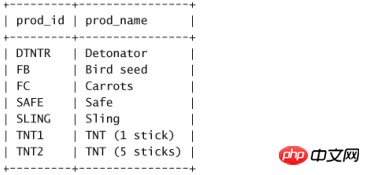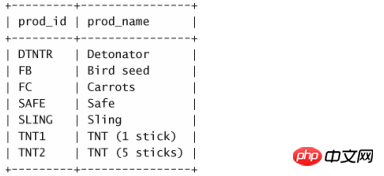mysql advanced join-self-join usage examples
Self-Join
As mentioned before, one of the main reasons for using table aliases is to reference the same table more than once in a single SELECT statement. Here's an example.
Suppose you find a problem with an item (whose ID is DTNTR ) and want to know if other items produced by the supplier that produces this item also have these problems. This query requires first finding the supplier
that produces the item with ID DTNTR, and then finding other items produced by this supplier.
Here is one way to solve this problem:
Input:
select prod_id,prod_name from products where vend_id = (select vend_id from products where prod_id = 'DTNTR');
Output:

Analysis: This is the first solution, which uses subqueries. The inner SELECT statement does a simple search and returns the vend_id of the item supplier whose production ID is DTNTR. This ID is used in the WHERE clause of the outer query to retrieve all items produced by this supplier.
Now look at the same query using joins:
Input:
select p1.prod_id,p1.prod_name from products as p1,products as p2 where p1.vend_id = p2.vend_id and p2.prod_id = 'DTNTR';
Output:
Analysis: This The two tables required in the query are actually the same table, so the products table appears twice in the FROM clause. Although this is perfectly legal, the reference to products is ambiguous because MySQL does not know which instance in the products table you are referring to. To solve this problem, table aliases are used. The first occurrence of products is the alias p1 , and the second occurrence is the alias p2 . These aliases can now be used as table names. For example, a SELECT statement uses the p1 prefix to explicitly give the full name of the required column. If not, MySQL will return an error because there are two columns named prod_id and prod_name respectively. MySQL doesn't know which column is wanted (even though they are actually the same column). WHERE (by matching vend_id in p1 and vend_id in p2) first joins the two tables, then filters the data by prod_id in the second table, returning the required data.
To solve this problem, table aliases are used. The first occurrence of products is the alias p1 , and the second occurrence is the alias p2 . These aliases can now be used as table names. For example, a SELECT statement uses the p1 prefix to explicitly give the full name of the required column. If not, MySQL will return an error because there are two columns named prod_id and prod_name respectively. MySQL doesn't know which column is wanted (even though they are actually the same column). WHERE (by matching vend_id in p1 and vend_id in p2) first joins the two tables, then filters the data by prod_id in the second table, returning the required data.
Use self-joins instead of subqueries. Self-joins are often used as external statements to replace subquery statements used when retrieving data from the same table. Although the end result is the same, sometimes processing joins is much faster than processing subqueries. You should try both methods to determine which performs better.
The above is the detailed content of mysql advanced join-self-join usage examples. For more information, please follow other related articles on the PHP Chinese website!

Hot AI Tools

Undresser.AI Undress
AI-powered app for creating realistic nude photos

AI Clothes Remover
Online AI tool for removing clothes from photos.

Undress AI Tool
Undress images for free

Clothoff.io
AI clothes remover

Video Face Swap
Swap faces in any video effortlessly with our completely free AI face swap tool!

Hot Article

Hot Tools

Notepad++7.3.1
Easy-to-use and free code editor

SublimeText3 Chinese version
Chinese version, very easy to use

Zend Studio 13.0.1
Powerful PHP integrated development environment

Dreamweaver CS6
Visual web development tools

SublimeText3 Mac version
God-level code editing software (SublimeText3)

Hot Topics
 MySQL's Role: Databases in Web Applications
Apr 17, 2025 am 12:23 AM
MySQL's Role: Databases in Web Applications
Apr 17, 2025 am 12:23 AM
The main role of MySQL in web applications is to store and manage data. 1.MySQL efficiently processes user information, product catalogs, transaction records and other data. 2. Through SQL query, developers can extract information from the database to generate dynamic content. 3.MySQL works based on the client-server model to ensure acceptable query speed.
 How to start mysql by docker
Apr 15, 2025 pm 12:09 PM
How to start mysql by docker
Apr 15, 2025 pm 12:09 PM
The process of starting MySQL in Docker consists of the following steps: Pull the MySQL image to create and start the container, set the root user password, and map the port verification connection Create the database and the user grants all permissions to the database
 Laravel Introduction Example
Apr 18, 2025 pm 12:45 PM
Laravel Introduction Example
Apr 18, 2025 pm 12:45 PM
Laravel is a PHP framework for easy building of web applications. It provides a range of powerful features including: Installation: Install the Laravel CLI globally with Composer and create applications in the project directory. Routing: Define the relationship between the URL and the handler in routes/web.php. View: Create a view in resources/views to render the application's interface. Database Integration: Provides out-of-the-box integration with databases such as MySQL and uses migration to create and modify tables. Model and Controller: The model represents the database entity and the controller processes HTTP requests.
 Solve database connection problem: a practical case of using minii/db library
Apr 18, 2025 am 07:09 AM
Solve database connection problem: a practical case of using minii/db library
Apr 18, 2025 am 07:09 AM
I encountered a tricky problem when developing a small application: the need to quickly integrate a lightweight database operation library. After trying multiple libraries, I found that they either have too much functionality or are not very compatible. Eventually, I found minii/db, a simplified version based on Yii2 that solved my problem perfectly.
 How to install mysql in centos7
Apr 14, 2025 pm 08:30 PM
How to install mysql in centos7
Apr 14, 2025 pm 08:30 PM
The key to installing MySQL elegantly is to add the official MySQL repository. The specific steps are as follows: Download the MySQL official GPG key to prevent phishing attacks. Add MySQL repository file: rpm -Uvh https://dev.mysql.com/get/mysql80-community-release-el7-3.noarch.rpm Update yum repository cache: yum update installation MySQL: yum install mysql-server startup MySQL service: systemctl start mysqld set up booting
 Centos install mysql
Apr 14, 2025 pm 08:09 PM
Centos install mysql
Apr 14, 2025 pm 08:09 PM
Installing MySQL on CentOS involves the following steps: Adding the appropriate MySQL yum source. Execute the yum install mysql-server command to install the MySQL server. Use the mysql_secure_installation command to make security settings, such as setting the root user password. Customize the MySQL configuration file as needed. Tune MySQL parameters and optimize databases for performance.
 Laravel framework installation method
Apr 18, 2025 pm 12:54 PM
Laravel framework installation method
Apr 18, 2025 pm 12:54 PM
Article summary: This article provides detailed step-by-step instructions to guide readers on how to easily install the Laravel framework. Laravel is a powerful PHP framework that speeds up the development process of web applications. This tutorial covers the installation process from system requirements to configuring databases and setting up routing. By following these steps, readers can quickly and efficiently lay a solid foundation for their Laravel project.
 MySQL vs. Other Programming Languages: A Comparison
Apr 19, 2025 am 12:22 AM
MySQL vs. Other Programming Languages: A Comparison
Apr 19, 2025 am 12:22 AM
Compared with other programming languages, MySQL is mainly used to store and manage data, while other languages such as Python, Java, and C are used for logical processing and application development. MySQL is known for its high performance, scalability and cross-platform support, suitable for data management needs, while other languages have advantages in their respective fields such as data analytics, enterprise applications, and system programming.






